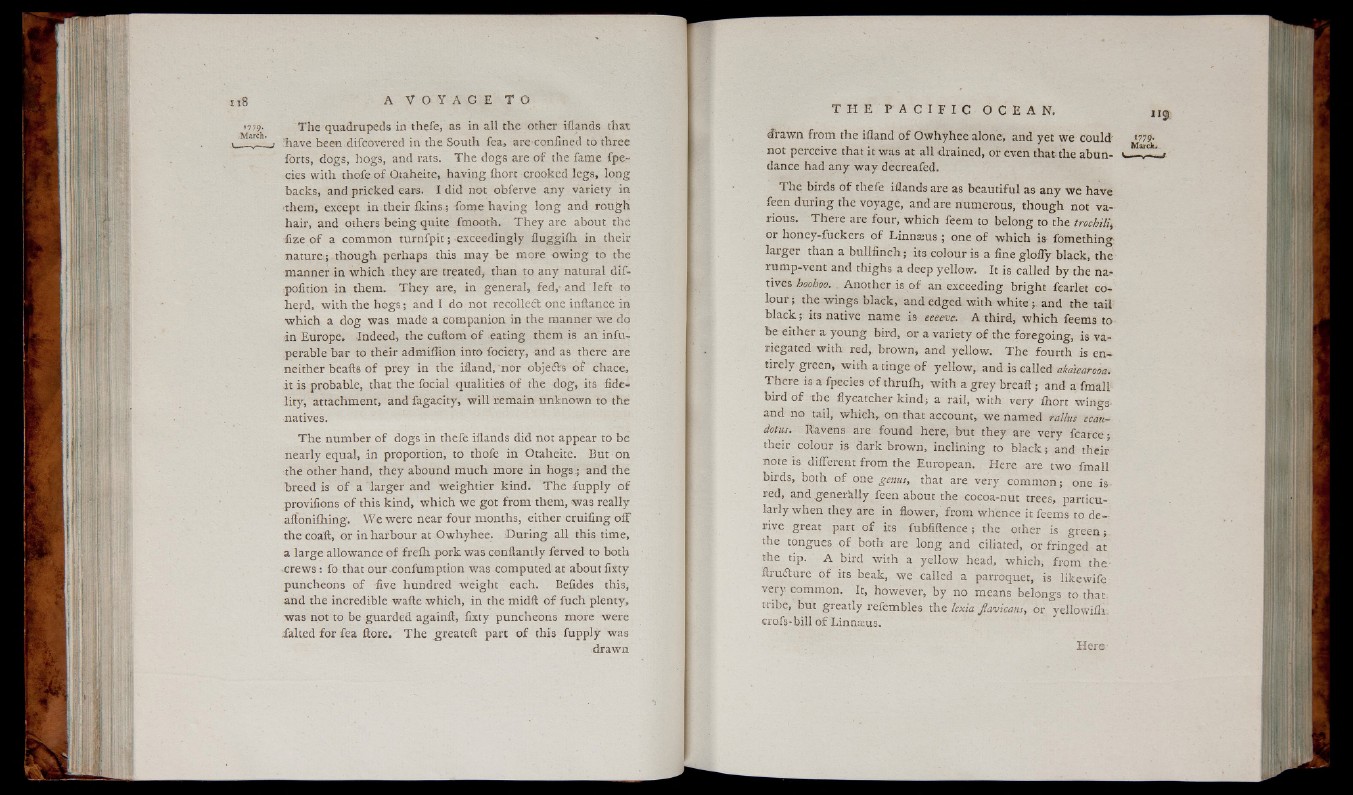
T h e quadrupeds in thefe, as in a ll the other iilands that
ha ve been difcovered in the South fea, a reconfined to three
forts, dogs, hogs, and rats. T he dogs are o f the fame fpe-
cies with thofe o f Otaheite, ha vin g ihort crooked legs, lo n g
backs, and pricked ears. I did not obferve any va rie ty in
•them, except in their ik in s ; fome h a vin g lo n g and ro u gh
hair, and others b e in g quite fmooth. T h e y are about the
fize o f a common tu rn fp it ; exceedingly flu g g iih in their
n a tu r e ; thou gh perhaps this m a y be more ow in g to the
manner in w h ich the y are treated, than to any natural dif-
pofition in them. T h e y are, in general, fed,- and le ft to
herd, -with the h o g s ; and I do not recoiled! one inftance in
w h ich a do g was made a companion in the manner w e do
■in Europe. Indeed, the cuftom o f eating them is an infu-
perable bar to their admiffion into fociety, and as there are
neither beafts o f prey in the ifland, nor objedts o f chace,
it is probable, that the focial qualities o f the dog, its fidelity,
attachment, and fagacity, w ill remain unknown to the
natives.
T h e number o f dogs in thefe iilands did not appear to be
n ea rly equal, in proportion, to thofe in Otaheite. But on
the other hand, they abound m u ch more in hogs ; and the
breed is o f a larger and w e igh tie r kin d. T h e fu p p ly o f
provifions o f this kin d, w h ich we g o t from them, was really
aftonifhing. We were near fo u r months, either cruifing o ff
the coaft, or in harbour at Owhyhee. D u r in g all this time,
a la rge allowance o f fre ih po rk w as conftantly ferved to both
-crew s: fo that our-confumption was computed at about fixty
puncheons o f five hundred w e igh t each. Befides this,
and the incredible wafte w h ich , in the midft o f fuch plenty,
was not to be guarded againft, fixty puncheons more were
failed fo r fea ftore. T h e greateft part o f this fupply was
drawn
sfrawn from the iiland o f Owh yh ee alone, and y e t w e could" lV9•
not perceive that it was at all drained, or even that the abun- «..-—.- I
dance had any w a y decreafed.
T h e birds o f thefe iilands are as beautiful as an y w e have
feen d u r in g the vo ya ge , and are numerous, thou gh not va rious.
T he re are four, w h ich feem to belong to the trochilij
or honey-fuckers o f L in n x u s ; one o f w h ich is fomething
la rg e r than a b u llfin ch ; its colour is a fine g loffy black, the
rump-vent and thighs a deep yellow. It is called b y the natives
hoohoo. . Another is o f an exceeding b right fearlet colour
; the w in g s black, and edged w ith white and the tail
b la ck ;, its native name is eeeeve, A third, w h ich feems to
be either a y o u n g bird, or a variety o f the foregoing , is v a riegated
w ith red,, brown, and yellow. T h e fourth is en—
tirely green, w ith a tinge o f y e llow , and is called akaiearooai
T h e re is a fpecies o f thruih, w ith a g r e y b re a ft; and a fmall
bird o f the flycatcher k in d ; a rail, with ve ry ihort wings-
and no tail, w h ich , on that account, w e named rallus ecau-
dotus. Ravens are found here, but they are ve ry fcarce-
their colour is dark brown, in clinin g to b la c k ; and their
note is different from the European. Here are two fmall
birds, both o f one genus, that are ve ry common; one is.
red, and gen e ra lly feen about the cocoa-nut trees, particula
rly w hen they are in flower, from whence it feems to derive
great part o f its fubfiftence ; the other is g r e e n ;
the tongues o f both are lon g and ciliated, or frin ged at
the tip. A bird w ith a y e llow head, which, from the-
ftrudture o f its beak, w e called a parroquet, is like wife
very common. It, however, by no means belongs to that
tiibe, but grea tly refembles the lexia Jlavicans, or yellowiih
crofs-bill o f Linnaeus.
Here